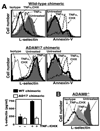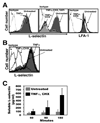ADAM17 activity and other mechanisms of soluble L-selectin production during death receptor-induced leukocyte apoptosis
- PMID: 20220092
- PMCID: PMC2858405
- DOI: 10.4049/jimmunol.0902925
ADAM17 activity and other mechanisms of soluble L-selectin production during death receptor-induced leukocyte apoptosis
Abstract
L-selectin is an adhesion molecule expressed by neutrophils that broadly directs their infiltration in to sites of inflammation. It is also present at relatively high levels in the serum of normal individuals. It is well established that L-selectin is efficiently shed from the surface of neutrophils upon their activation, a process that regulates its density and binding activity. Neutrophil programmed cell death is critical for the resolution of inflammation, and L-selectin downregulation is induced during this process as well. The mechanisms underpinning this latter process are much less understood, and were investigated in this study. Using a disintegrin and metalloprotease (ADAM)-17 radiation chimeric mice, we demonstrate for the first time that during early events of death receptor-mediated neutrophil apoptosis, L-selectin downregulation occurs primarily by ADAM17-mediated shedding. This was observed as well upon using shRNA to knock down ADAM17 expression in Jurkat cells, a well-studied cell line in terms of the molecular processes involved in the induction of apoptosis. These findings directly reveal that ADAM17 activity occurs during programmed cell death. Hence, the cleavage of particular ADAM17 substrates may be an additional component of the anti-inflammatory program initiated by apoptotic neutrophils. Of interest was that during later stages of induced leukocyte apoptosis, soluble L-selectin production occurred independent of ADAM17, as well as membrane events, such as blebbing and microparticle production. This process may provide an explanation for the lack of diminished serum L-selectin levels in ADAM17-null mice, and suggests a mechanism for the homeostatic maintenance of soluble L-selectin levels in the blood of healthy individuals.
Figures





Similar articles
-
Ectodomain Shedding by ADAM17: Its Role in Neutrophil Recruitment and the Impairment of This Process during Sepsis.Front Cell Infect Microbiol. 2017 Apr 25;7:138. doi: 10.3389/fcimb.2017.00138. eCollection 2017. Front Cell Infect Microbiol. 2017. PMID: 28487846 Free PMC article. Review.
-
ADAM17 deficiency by mature neutrophils has differential effects on L-selectin shedding.Blood. 2006 Oct 1;108(7):2275-9. doi: 10.1182/blood-2006-02-005827. Epub 2006 May 30. Blood. 2006. PMID: 16735599 Free PMC article.
-
Regulation of mature ADAM17 by redox agents for L-selectin shedding.J Immunol. 2009 Feb 15;182(4):2449-57. doi: 10.4049/jimmunol.0802770. J Immunol. 2009. PMID: 19201900 Free PMC article.
-
Adam17-dependent shedding limits early neutrophil influx but does not alter early monocyte recruitment to inflammatory sites.Blood. 2011 Jul 21;118(3):786-94. doi: 10.1182/blood-2010-11-321406. Epub 2011 May 31. Blood. 2011. PMID: 21628404 Free PMC article.
-
[The two sides of ADAM17 in inflammation: implications in atherosclerosis and obesity].Med Sci (Paris). 2009 Jan;25(1):45-50. doi: 10.1051/medsci/200925145. Med Sci (Paris). 2009. PMID: 19154693 Review. French.
Cited by
-
Novel regulatory mechanisms for generation of the soluble leptin receptor: implications for leptin action.PLoS One. 2012;7(4):e34787. doi: 10.1371/journal.pone.0034787. Epub 2012 Apr 24. PLoS One. 2012. PMID: 22545089 Free PMC article.
-
Human CD6 Down-Modulation following T-Cell Activation Compromises Lymphocyte Survival and Proliferative Responses.Front Immunol. 2017 Jun 30;8:769. doi: 10.3389/fimmu.2017.00769. eCollection 2017. Front Immunol. 2017. PMID: 28713387 Free PMC article.
-
Ectodomain Shedding by ADAM17: Its Role in Neutrophil Recruitment and the Impairment of This Process during Sepsis.Front Cell Infect Microbiol. 2017 Apr 25;7:138. doi: 10.3389/fcimb.2017.00138. eCollection 2017. Front Cell Infect Microbiol. 2017. PMID: 28487846 Free PMC article. Review.
-
Adenosine monophosphate deaminase 3 null mutation causes reduction of naive T cells in mouse peripheral blood.Blood Adv. 2020 Aug 11;4(15):3594-3605. doi: 10.1182/bloodadvances.2020001762. Blood Adv. 2020. PMID: 32761233 Free PMC article.
-
Phosphatidylserine exposure is required for ADAM17 sheddase function.Nat Commun. 2016 May 10;7:11523. doi: 10.1038/ncomms11523. Nat Commun. 2016. PMID: 27161080 Free PMC article.
References
-
- Black RA. Tumor necrosis factor-alpha converting enzyme. Int. J. Biochem. Cell Biol. 2002;34:1–5. - PubMed
-
- Arribas J, Borroto A. Protein ectodomain shedding. Chem. Rev. 2002;102:4627–4638. - PubMed
-
- Dello Sbarba P, Rovida E. Transmodulation of cell surface regulatory molecules via ectodomain shedding. Biol. Chem. 2002;383:69–83. - PubMed
-
- Tousseyn T, Jorissen E, Reiss K, Hartmann D. (Make) stick and cut loose--disintegrin metalloproteases in development and disease. Birth Defects Res. Part C, Embryo Today. 2006;78:24–46. - PubMed
-
- Garton KJ, Gough PJ, Raines EW. Emerging roles for ectodomain shedding in the regulation of inflammatory responses. J. Leukoc. Biol. 2006;79:1105–1116. - PubMed
Publication types
MeSH terms
Substances
Grants and funding
LinkOut - more resources
Full Text Sources
Molecular Biology Databases
Miscellaneous

